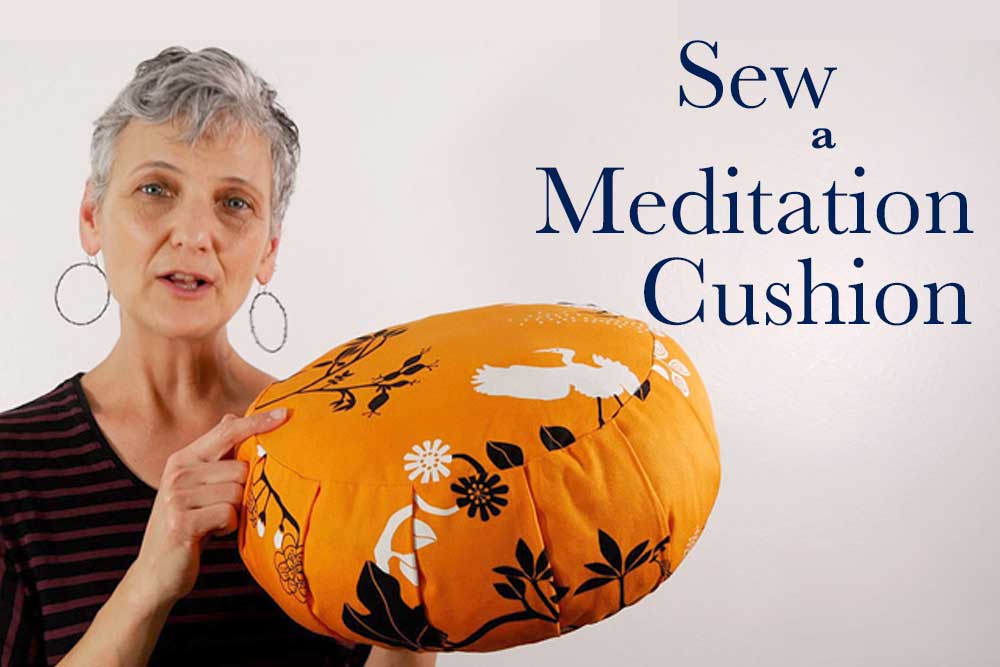
Turns out I need to relax more. At first, I thought this meant days poolside however I have no pool and it turns out a day of doing nothing only brings on more stress for some of us.
What I need, so suggested the doc, is to relax a little every day and practice not getting stressed about minor things in the first place. What I need, she prescribed, is to focus on my breath, for five minutes, five times a day.
What becomes clear in the first minute is it isn’t that easy (yet) and it’s near impossible if you are uncomfortable because discomfort trumps breath when it comes to focus.
And this is why they have a cushion just for meditation: right size, right height, right firmness.
And hey, some aren’t that expensive but…why can’t I make my own? (You know, it’s all about reducing my stress so I’m going to make it into a project, that I film 😉 )(This is becoming enlightening)
But yes, you can make your own meditation cushion.
It’s easy, almost super easy and it’s quick. It doesn’t require much fabric and you could use scraps to piece the pieces or a different fabric for each piece. The hardest and most expensive part is the stuffing. Whatever you choose to stuff your cushion with you’ll need a lot of it.
Watch This Video for the How-To:
Better made zafus (A meditation cushion is called a zafu) are stuffed with Kapok or Buckwheat Hulls. Kapok is environmentally very friendly (no pesticides and sustainable). Buckwheat hulls are dense to provide firm support.
You can also use what you have on hand, as I did. A mixture of cotton batting scraps, leftover polyfill, fabric scraps plus old t-shirts and foam packaging sheets.
Note: Originally this post was just the video and some quick steps. I’ve since added more details but the photos are screenshots from the video. I apologize for any slightly blurry images
This project works best with 59″ (150 cm) wide fabric. However, you can piece together fabric if yours is not that wide. Choose a fabric that is on the heavy side like canvas, duck, denim or upholstery fabric. Many of these come 59″ wide so, bonus.
Most zafus come 6 to 9 inches tall (15 to 23 cms) and 12 to 14 inches (30 to 35 cms) in diameter. If you are a tall person you will want to make the cushion 9″ tall. Of course, it’s your cushion and you can make it as large and tall as you would find comfortable. I am 5’7″ tall and made a 6″ tall cushion. It’s fine)
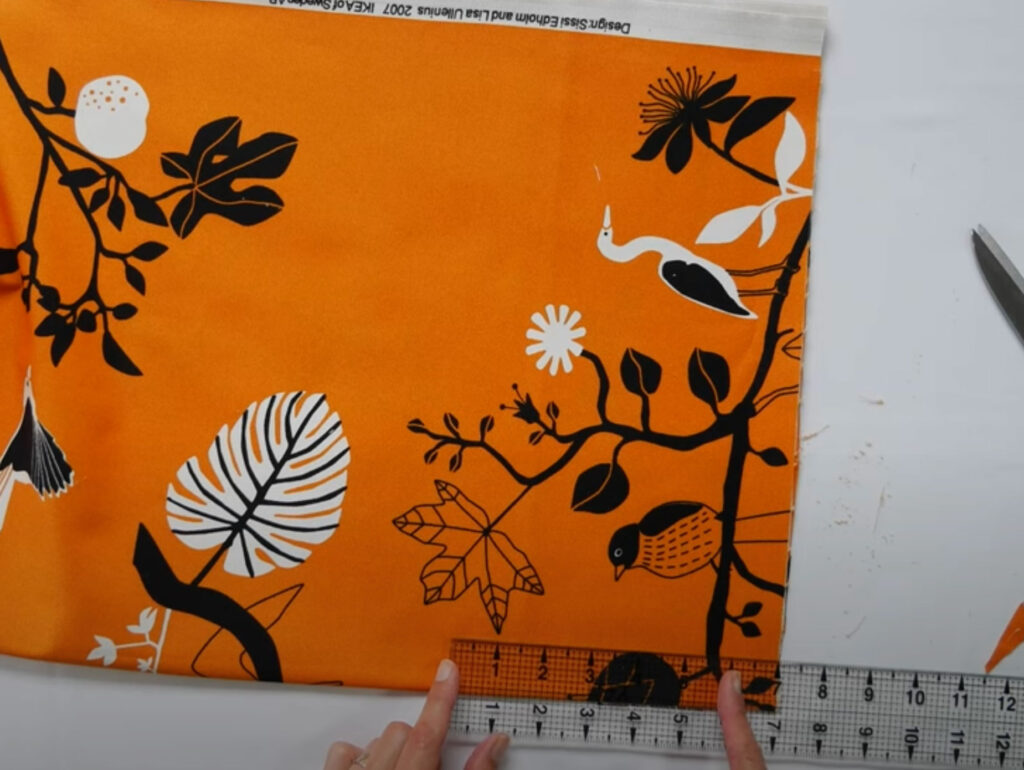
You will need to cut one long strip of fabric for the side piece and 2 circles for the top and bottom. The side should be 59″ long and however tall (suggested 6 to 9 inches) PLUS seam allowance. TIP: cut one long strip across your wide fabric leaving the selvedge on the fabric. If you have narrower fabric piece two strips together to make a 59″ long strip and you could piece two strips to have a selvedge edge of fabric for the two short ends of the strip.
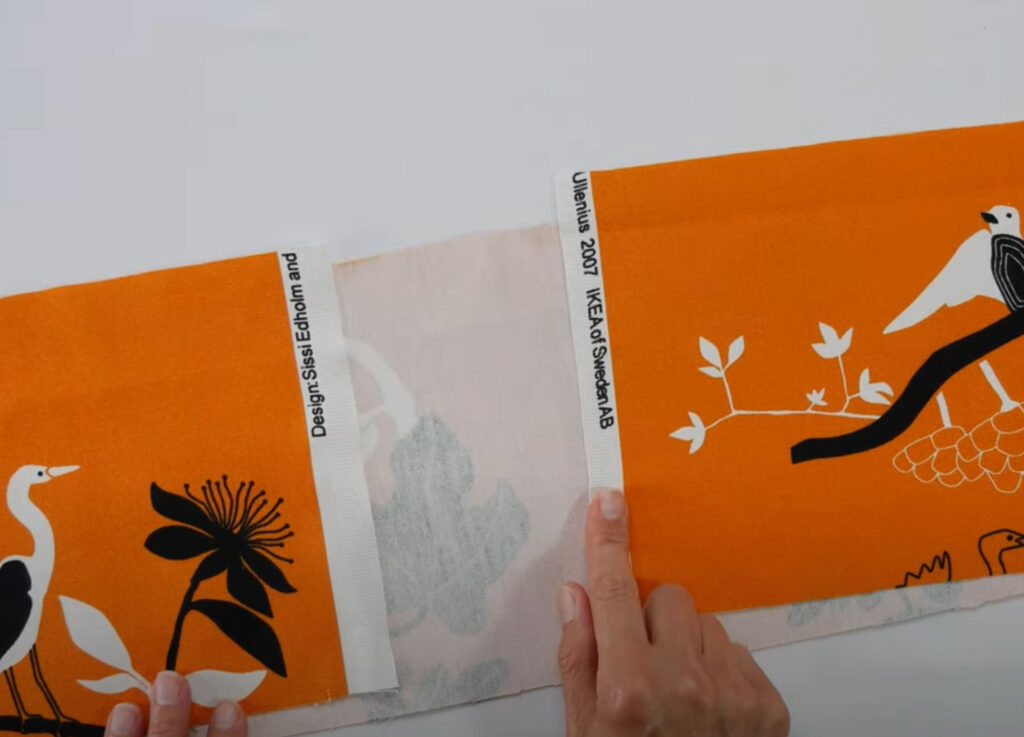
If the short edges of your side piece are not selvedge then overcast them with an overcast stitch or a zigzag stitch. The side will overlap itself when done. One edge will be covered and the overlapping edge will be folded over just once.
If your fabric is not quite 59″ wide you will be ok. There is some wiggle room.
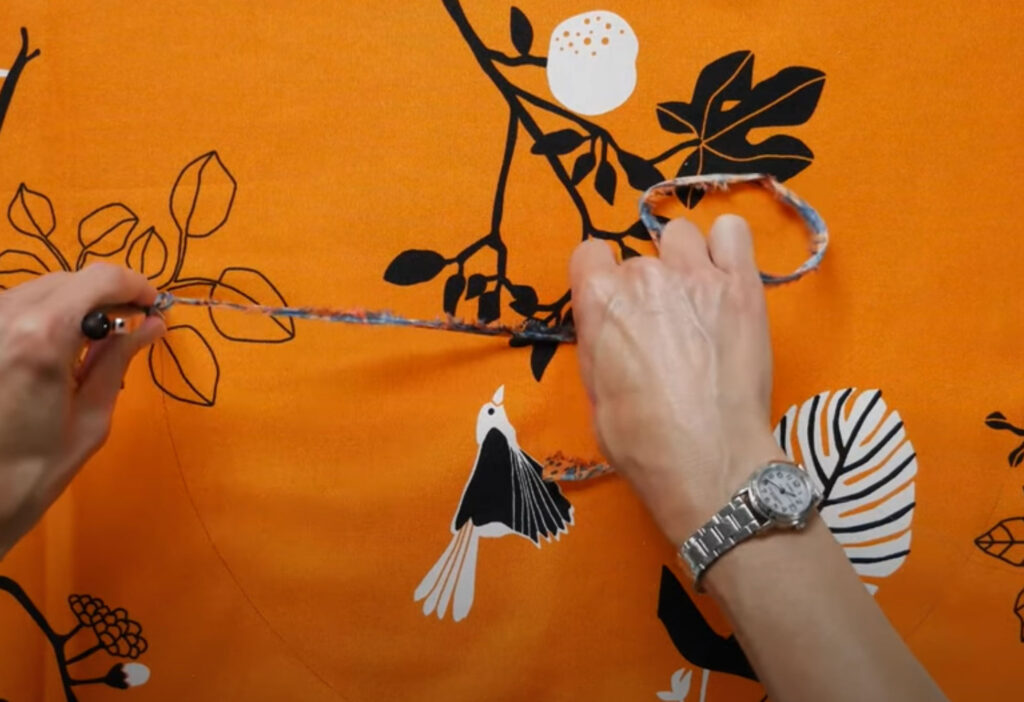
Cut out the circles. Add the same amount of seam allowance you used on the side piece.
I find the easiest way to make a circle is tie a string (or I used a selvedge) to a pencil. Measure over on the string from the pencil to the amount equal to half your circle diameter (plus seam allowance). Put a pin in the string at that amount. Stick the pin in the fabric, swing the pencil around in a smooth arc and draw a circle.
Math example: I want a cushion 12″ in diameter when finished. I am using a half inch seam allowance. 12″ plus .5″ sa for the right side + .5″ sa for the left =13″. Divid 13″ in half for the radius = 6.5″. The pin is 6.5″ away from the pencil in the string.
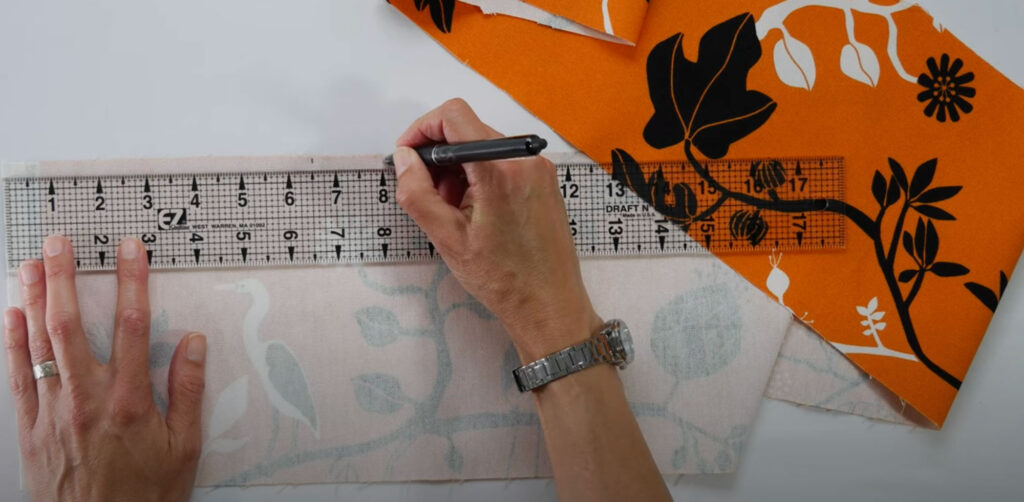
The side piece of a meditation cushion is pleated. Make pleat marks across one long edge on the wrong side of the fabric starting from the left short edge.
Measure 6.5″ (16.5 cms) in from the left.
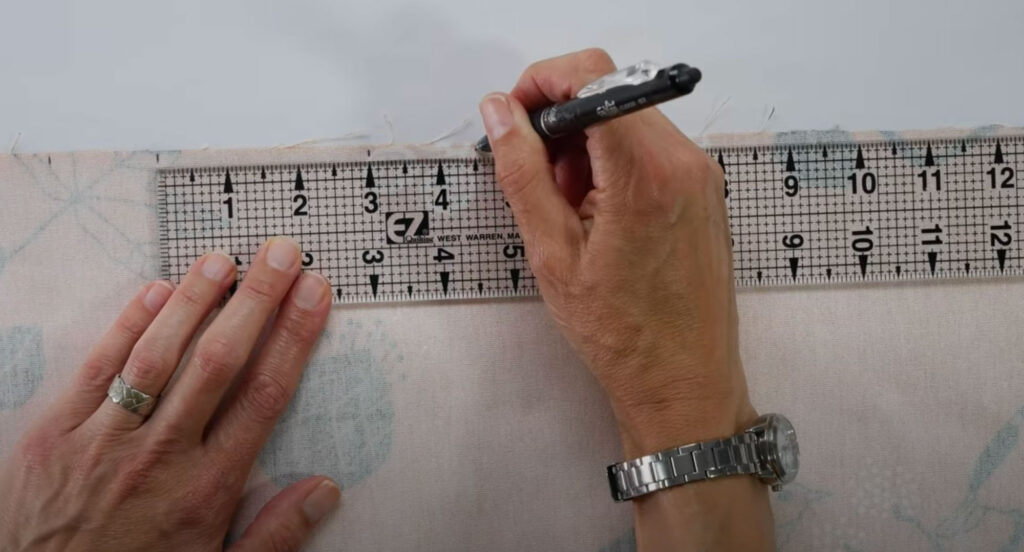
Measure over 1.5″ (a shy 4 cms) from that first mark and make a second mark.
Measure over 3″ (7.5 cms)from the second mark and make a third mark.
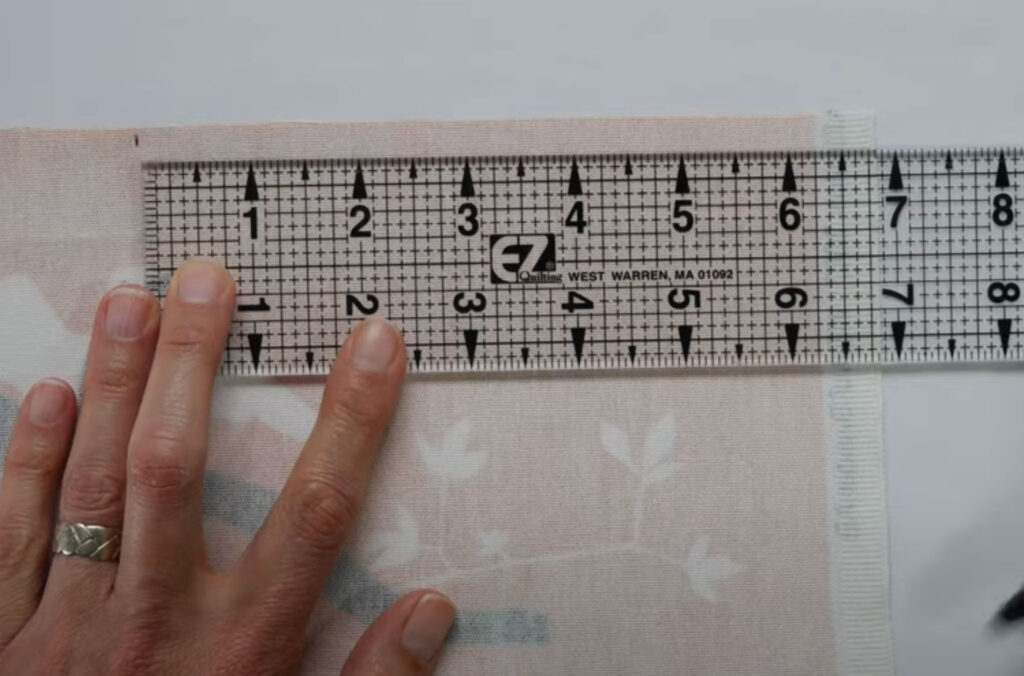
Measure over 1.5″, mark. Then 3″, mark and repeat until you have about 5 or 6″ (15 cms) left at the far end of the side strip.
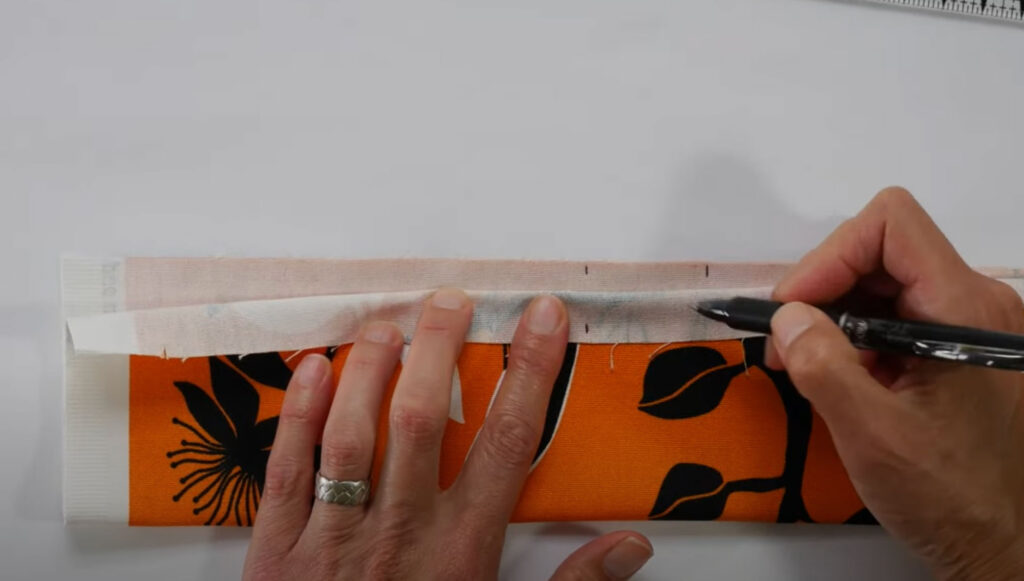
Transfer these marks to the other long edge of the side piece. I did this by simply folding the strip lengthwise and marking the unmarked edge. Since an exact fit is not needed for a cushion I was not going to be persnickety.
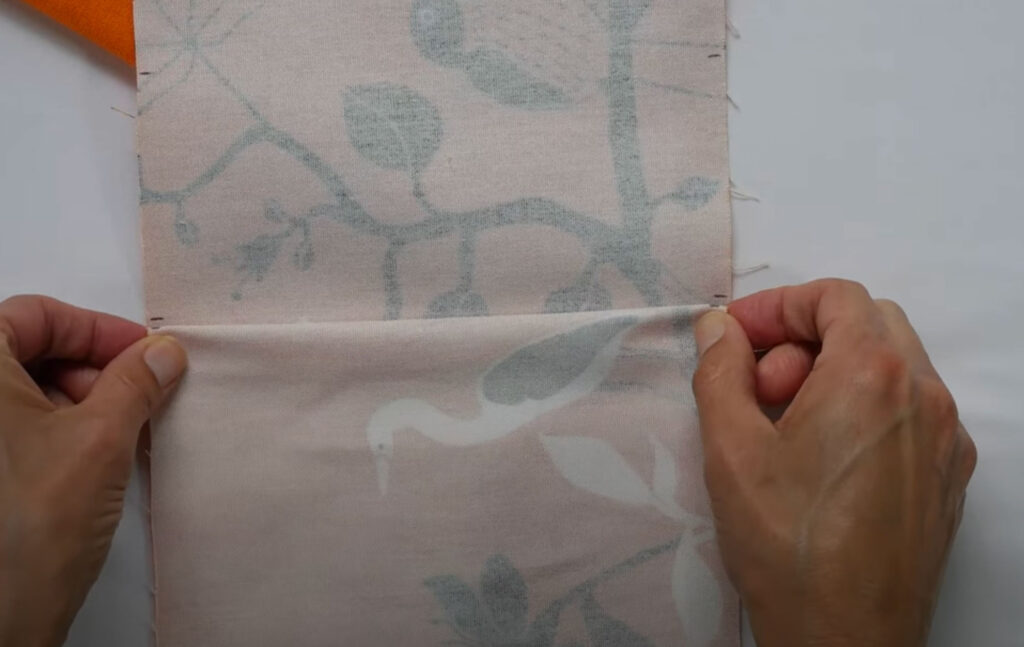
Fold the pleats by matching the first mark to the second mark (1.5 inches or 4 cms away) and pin them down. Match the third mark the the fourth, the fifth to the sixth and so on.
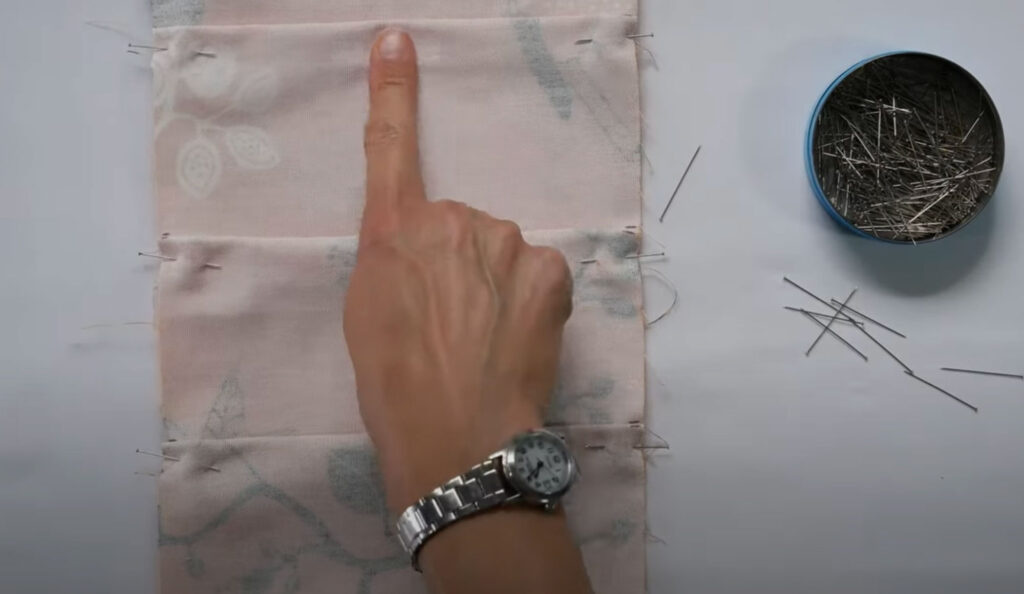
All the pleats will be going in one direction. Baste the pleats in place and iron them flat.
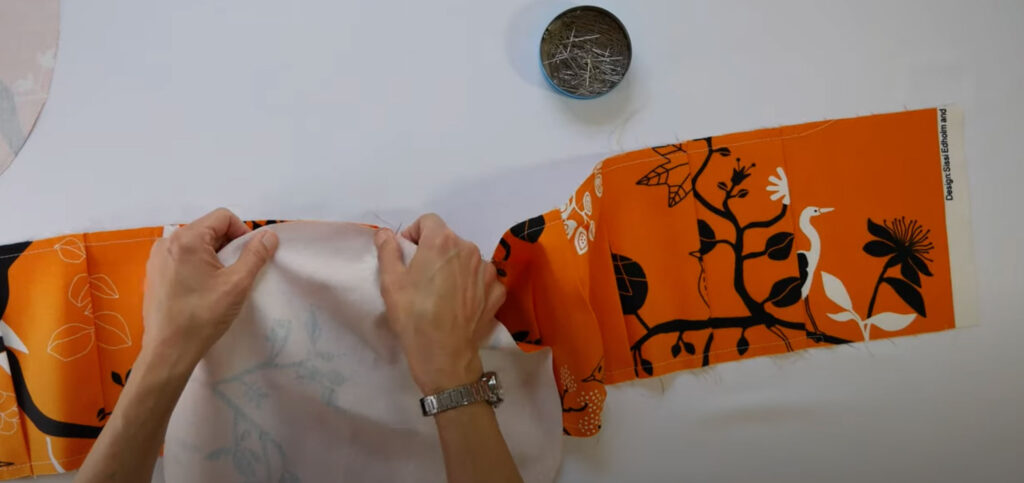
To pin the side to the top or bottom (eventually both but first just one circle), start in the center of the side piece and pin the top piece to the side piece lining up the raw edges. Pin in one direction until you have about 5 inches (12.5 cms) of the side left. Leave those 5″ of side unpinned. Go back to where you first started pinning the side to the top and start pinning the top to the side in the other direction until you have about 5 inches (12.5 cms) left.
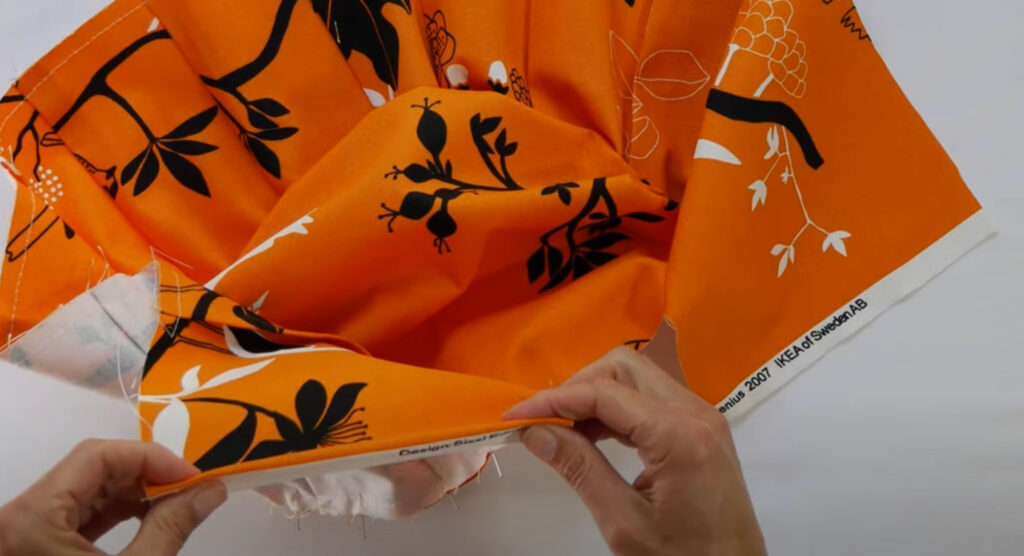
Remember the side piece will overlap itself. So now is when to figure out which end is overlapping and which is being overlapped. I suggest following the direction of your pleats. They direction they fold toward will tell you what direction the fabric should overlap itself (it’s the same).
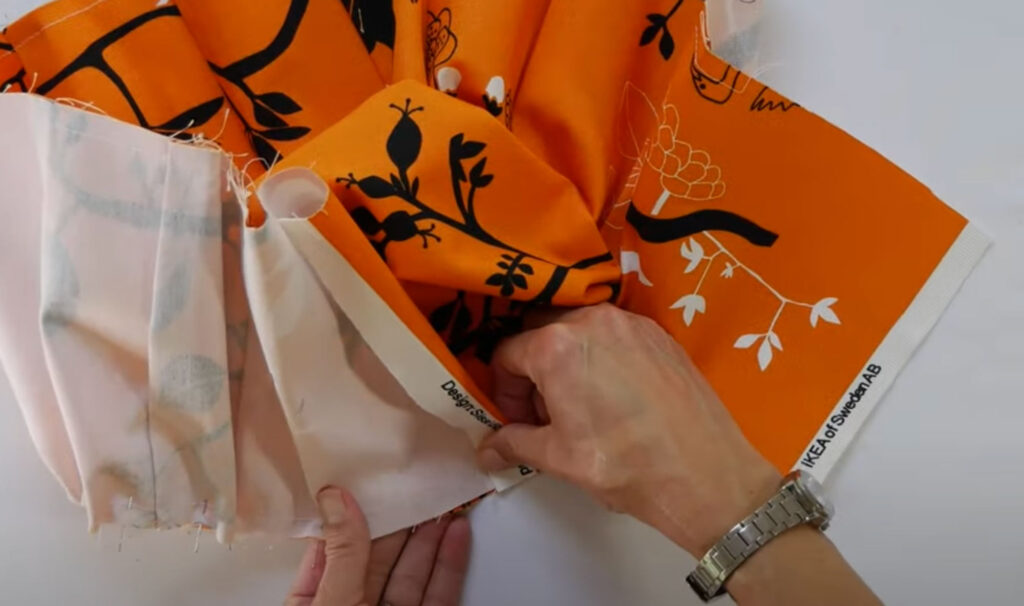
The overlapping edge is also the outside edge so it needs to be folded over about .5″-1″ to the inside or wrong side before it is pinned down to the top piece. It will be pinned down first. Then the end that will be under the overlap is pinned down to the top and a bit of the side.
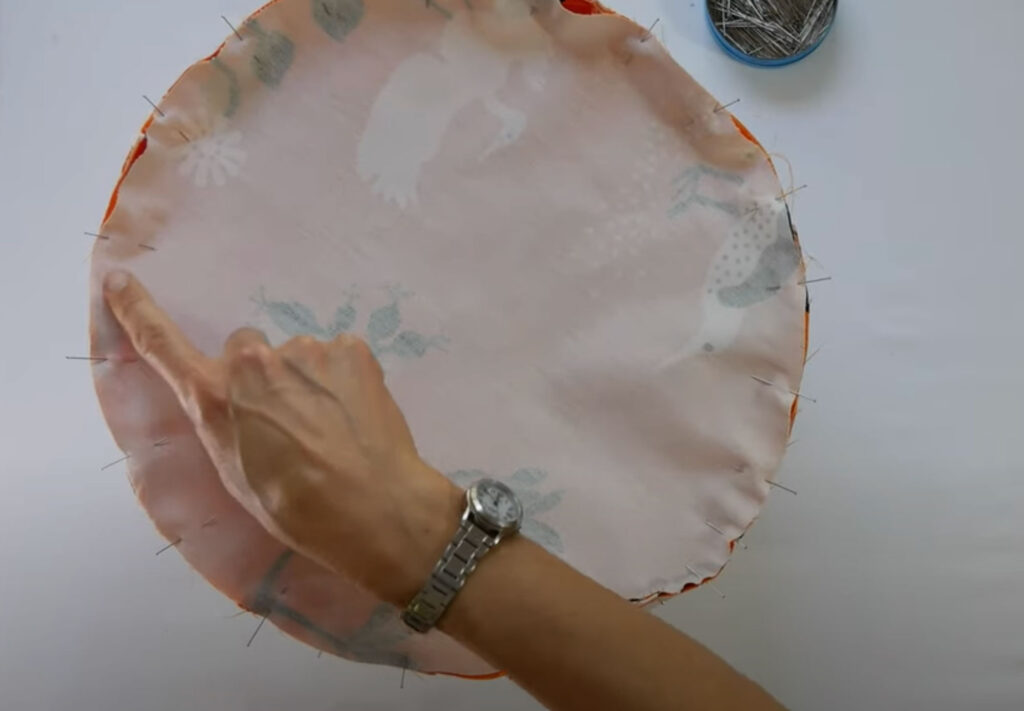
Sew the top to the side piece all the way around.
Pin the bottom to the side piece as you did the top. Pay attention to the overlapping ends so they don’t become twisted. Sew the bottom to the side piece all the way around.
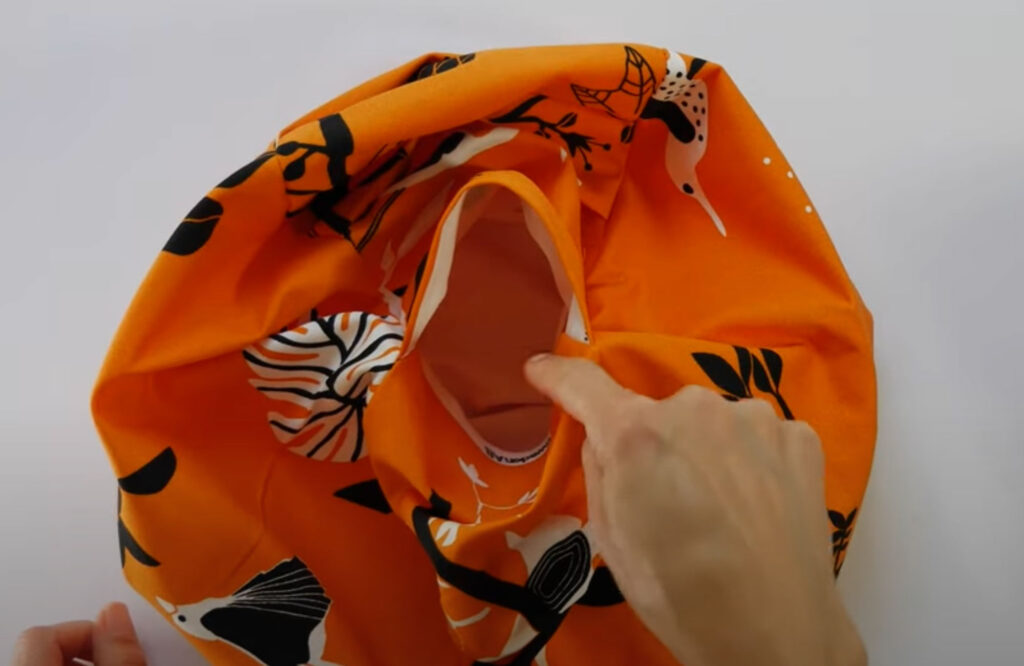
Stuff the cushion through the opening made by the overlap. You will be surprised how much stuffing is needed. Way more than you think.
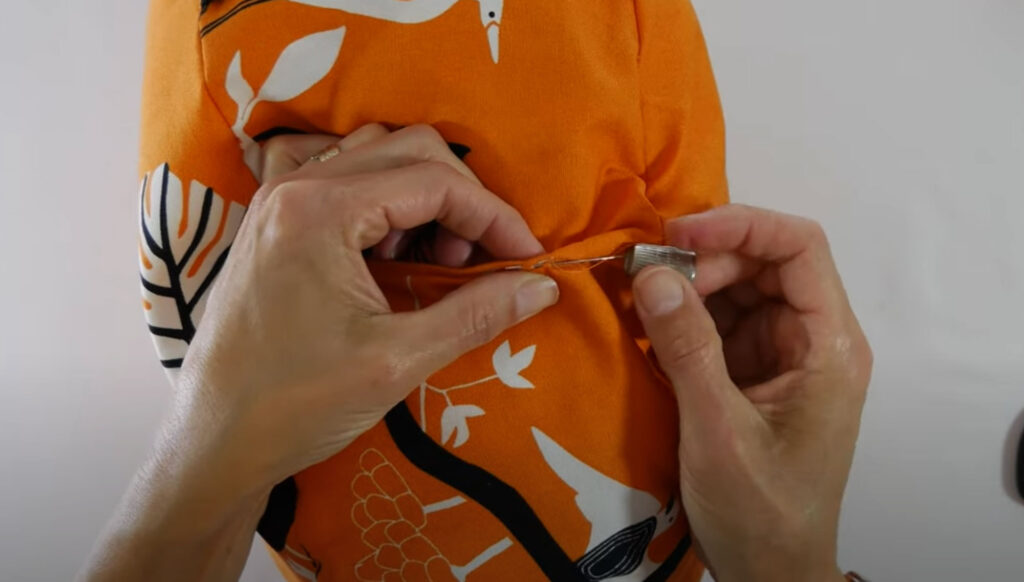
Hand stitch the opening/overlap closed

And that’s it. But really, the video has more detail if you want it.
How Do You Make a Washable Cover?
Make the pillow above using muslin or other medium-weight fabric. This would be the insert
Make a cover as above except since you’ll need a large opening to accommodate putting in and taking out the insert, do not sew the bottom completely to the side. Instead insert a zipper, at least 14″ long into the seam. The side seam could be sewn shut instead of being overlapped
The steps would be:
- Pleat the side and baste the pleats down
- Sew one edge of the zipper to the bottom edge of the side piece (somewhere in the center).
- Sew the other edge of the zipper the bottom piece.
- Close the zipper
- Line up the rest of the side to the bottom circle as above and sew the side to the bottom piece
- Pin the top to the side and sew together
- Unzip the zipper and insert the insert.
(Now the side could be hand stitched or sewn by machine after sewing the bottom and side together – to know where to sew the short ends together)

Thank-you for this helpful video! I made a meditation cushion this morning based on your design, and it turned out great. 🙂
I omitted the pleats on the side as I wanted a cushion that stays taller without bulging sideways. I also added a strip of fabric to the side as a carrying handle. I stuffed it with polystyrene micro-beads from an old pillow – they make a huge mess! but make for a comfortable cushion.
Thank-you again for creating and posting this video. It was just what I needed to make the cushion I wanted. I’m looking forward to trying it in meditation this evening!
I’m glad you found the post helpful. Those are great ideas – all of them! My cushion does bulge out at the sides. Using stuffing beads from an old pillow (I can’t imagine the mess 😉 is clever. I bet it is comfortable. I’m wondering if my kids left any such type of pillow in our attic… hmmm. And a handle is just smart. This is what I love about making things yourself – customizing to suit your needs and your supplies. Thanks for letting us know 🙂
I literally never leave comments but felt I need to thank you. This was a first ever sewing adventure. I don’t own a sewing machine and had to go buy pins plus thread and fabric to make this. And even though I didn’t put a seam allowance and hand stitched everything, watching your video helped make the finished product turn out perfectly. Thank you for your very clear directions!
(P.S. your contact form is not working)
I’m so happy you found the video helpful. Maybe this is the beginning of more sewing adventures – I mean, you do own pins now 😉 (and thanks for the info about the contact form. I’m looking into that next)
Thank you for this awesome explanation of how to make a meditation cushion! I have been sewing for only a few months and everything was very clear. I made a cushion filled with buckwheat and a cushion cover with an added handle, as Gail mentioned above. I made it for my husband who loves to meditate outside so I wanted to be able to wash the cover from time to time. Both turned out great and I can’t wait to give it to my husband on his birthday next week.
A handle is a great idea! especially if the person needs to take it outside, or any distance. I’m so happy you liked the post. Thanks for letting me know
I’m curious how you made the washable meditation cushion cover. If you could share instructions I would appreciate it!
I’ll add more details to the above steps today. Then you’ll have the instructions 😉
Thank you so much!
Awesome video-teaching is excellent. All steps explained so well!!!! Thank you as I will be making mine!!! A handle from the comments is a great idea when packed up for a Yoga class.
Thank you. A handle is a great idea.